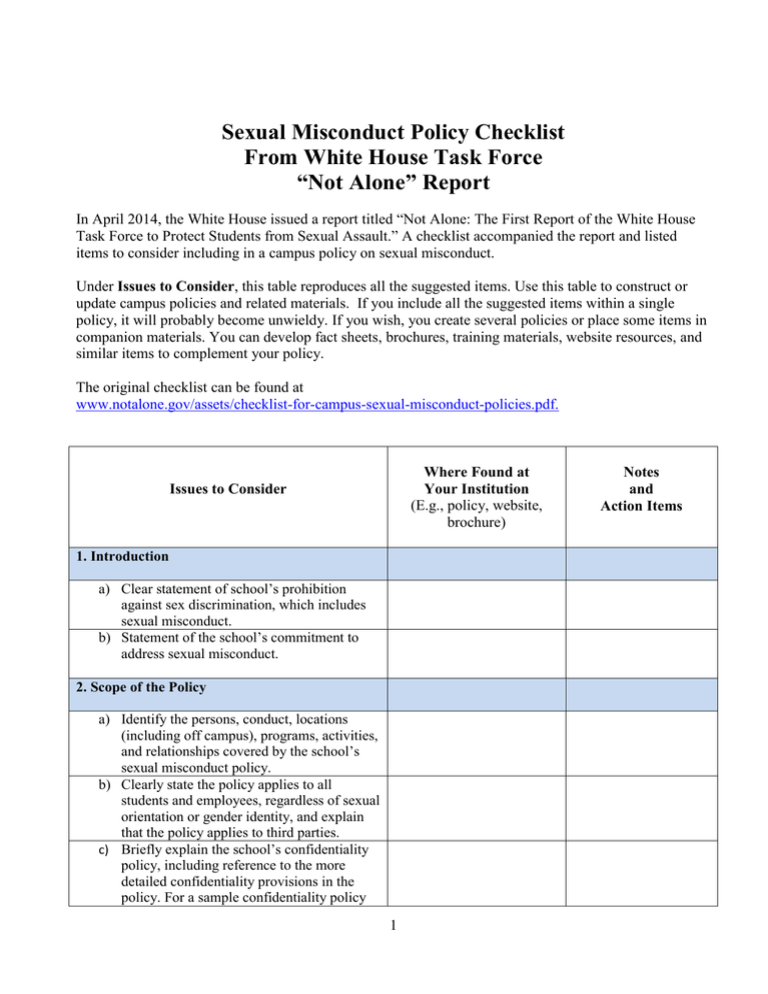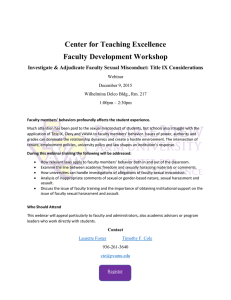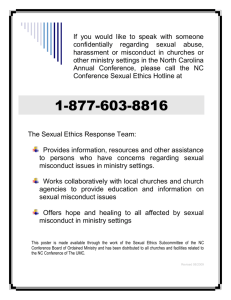
Sexual Misconduct Policy Checklist
From White House Task Force
“Not Alone” Report
In April 2014, the White House issued a report titled “Not Alone: The First Report of the White House
Task Force to Protect Students from Sexual Assault.” A checklist accompanied the report and listed
items to consider including in a campus policy on sexual misconduct.
Under Issues to Consider, this table reproduces all the suggested items. Use this table to construct or
update campus policies and related materials. If you include all the suggested items within a single
policy, it will probably become unwieldy. If you wish, you create several policies or place some items in
companion materials. You can develop fact sheets, brochures, training materials, website resources, and
similar items to complement your policy.
The original checklist can be found at
www.notalone.gov/assets/checklist-for-campus-sexual-misconduct-policies.pdf.
Where Found at
Your Institution
(E.g., policy, website,
brochure)
Issues to Consider
1. Introduction
a) Clear statement of school’s prohibition
against sex discrimination, which includes
sexual misconduct.
b) Statement of the school’s commitment to
address sexual misconduct.
2. Scope of the Policy
a) Identify the persons, conduct, locations
(including off campus), programs, activities,
and relationships covered by the school’s
sexual misconduct policy.
b) Clearly state the policy applies to all
students and employees, regardless of sexual
orientation or gender identity, and explain
that the policy applies to third parties.
c) Briefly explain the school’s confidentiality
policy, including reference to the more
detailed confidentiality provisions in the
policy. For a sample confidentiality policy
1
Notes
and
Action Items
Where Found at
Your Institution
(E.g., policy, website,
brochure)
Issues to Consider
go here:
http://notalone.gov/assets/reportingconfidentiality-policy.pdf
3. Options for Assistance Following an Incident
of Sexual Misconduct
a) Immediate Assistance
i.
ii.
iii.
iv.
Identify and provide contact information for
the trained on- and off-campus advocates
and counselors who can provide an
immediate confidential response in a crisis
situation (e.g., obtain needed resources,
explain reporting options, and help
navigate the reporting process).
Provide emergency numbers for on- and
off- campus safety, law enforcement, and
other first responders (e.g., the Title IX
coordinator).
Describe the sexual assault response team
(SART) process and resources SART
members can offer.
Identify health care options, both on- and
off- campus.
1. Ensure the victim is aware of the options
to seek treatment for injuries,
preventative treatment for sexually
transmitted diseases, and other health
services.
2. Discuss the option of seeking medical
treatment in order to preserve evidence.
3. Identify where/how to get a rape kit or
find a Sexual Assault Nurse Examiner
(SANE).
4. List locations, including contact
information, for an advocate (e.g., a
local rape crisis center, on-campus
advocacy program) who can accompany
a victim to the hospital or health
provider.
2
Notes
and
Action Items
Where Found at
Your Institution
(E.g., policy, website,
brochure)
Issues to Consider
b) Ongoing Assistance
i. Counseling, Advocacy, and Support – On
and Off Campus
1. Identify counseling and support for
victims of sexual misconduct, whether
or not a victim chooses to make an
official report of participate in the
institutional disciplinary or criminal
process.
2. Identify options for disclosing
confidentiality with counseling,
advocacy, health, mental health, or
sexual-misconduct-related sources, both
on and off campus.
3. Identify those who can provide ongoing
support during the institutional
disciplinary or criminal process.
ii. Academic Accommodations and Interim
Measures
1. Describe the immediate steps and
interim measures that the school can
provide to ensure the safety and wellbeing of the victim, such as the ability to
move dorms, change work schedules,
alter academic schedules, withdraw
from-retake a class without penalty, and
access academic support (e.g., tutoring).
2. Describe additional interim measures
that the school may be able to provide
for complainants while an investigation
is pending such as no contact orders and
changing the alleged perpetrator’s living
arrangements or course schedule. See
Section 7.g about interim measures.
4. Title IX Coordinator
a) Identify the school’s Title IX coordinator and
briefly explain the Title IX coordinator’s role in
the school’s overall response to sexual
misconduct; provide references to sections of
3
Notes
and
Action Items
Where Found at
Your Institution
(E.g., policy, website,
brochure)
Issues to Consider
the policy that provide greater details regarding
the Title IX coordinator’s duties.
5. Definitions
a) Clearly define all conduct prohibited by the
policy, including:
i.
Sexual harassment
ii.
iii.
Hostile environment caused by sexual
harassment
Sexual assault
1. Non-consensual sexual contact, and
2. Non-consensual sexual intercourse
iv.
Domestic violence
v.
Dating violence
vi.
Sexual exploitation
vii.
Stalking
viii.
Retaliation
ix.
Intimidation
b) Additional terms that should be defined include:
i.
Consent – The input of students and
sexual assault experts can be helpful in
developing a definition of consent. At
minimum, the definition should
recognize that:
Consent is a voluntary
agreement to engage in sexual
activity.
Someone who is incapacitated
cannot consent.
4
Notes
and
Action Items
Where Found at
Your Institution
(E.g., policy, website,
brochure)
Issues to Consider
ii.
Past consent does not imply
future consent.
Silence or an absence of
resistance does not imply
consent.
Consent to engage in sexual
activity with one person does not
imply consent to engage in
sexual activity with another.
Consent can be withdrawn at
any time.
Coercion, force, or threat of
either invalidates consent.
Incapacitation (such as due to the use of
drugs or alcohol, when a person is
asleep or unconscious, or because of an
intellectual or other disability that
prevents the student from having the
capacity to give consent)
6. Reporting Policies and Protocols
a) Identify formal reporting options – e.g., criminal
complaint, institutional complaint, report to
“responsible employee,” including the Title IX
coordinator. Explain how each option works and
include contact information for the people to
whom one can make a report.
b) Identify alternative to reporting – e.g.,
privileged or confidential disclosures
c) Describe policies governing confidentiality
i.
Specify those employees to whom a
student can disclose in confidence and
those “responsible employees” who
must report incidents (including
personally identifying details) to the
Title IX Coordinator. Consider
particularly how a school will ensure
that a student understands an
employee’s reporting obligation before
5
Notes
and
Action Items
Where Found at
Your Institution
(E.g., policy, website,
brochure)
Issues to Consider
d)
e)
f)
g)
he or she reveals any information to that
employee.
ii.
Describe what information will be kept
confidential and what information may
be disclosed, to whom it will be
disclosed, and why.
iii.
Explain when the school may not be
able to honor a student’s request that his
or her name not be disclosed to the
alleged perpetrator or that no
investigatory or disciplinary action be
taken. Identify the employee responsible
for evaluating such requests for
confidentiality or no action.
Explain the school’s reporting obligations under
the Clery Act, including the annual reporting
responsibilities of Campus Security Authorities
and the school’s obligation to issue timely
warnings.
Explain the process for third-party and
anonymous reporting.
Ensure the policy prohibits retaliation against
those who file a complaint or third-party report,
or otherwise participate in the investigative
and/or disciplinary process (e.g., as a witness),
and explain that the school will take strong
responsive action if retaliation occurs.
Describe when the school will grant amnesty
from drug, alcohol, and other student conduct
policies.
7. Investigation Procedures and Protocols
a) Identify the Title IX Coordinator(s) and explain
roles and responsibilities.
b) Identify who conducts the investigation and
what an investigation might entail.
c) Specify a reasonably prompt time frame for
conducting the investigation and resolving the
complaint, as well as the process for extending
the timeframe.
6
Notes
and
Action Items
Where Found at
Your Institution
(E.g., policy, website,
brochure)
Issues to Consider
d) Explain the processes for preserving evidence.
e) Provide the respondent and complainant
equitable rights during the investigative process.
f) Set forth parameters and clarify what
information may and may not be shared during a
parallel investigation with law enforcement
(e.g., via a Memorandum of Understanding with
local law enforcement).
g) Explain that where necessary, the school will
take immediate steps to protect complainants
pending the final outcome of an investigation,
including academic accommodations and other
interim measures. These steps may include the
ability to change housing or dining facilities;
change work schedules; alter academic
schedules; withdraw from/retake a class without
penalty; access academic support such as
tutoring; issue no contact orders; and change the
alleged perpetrator’s living arrangements or
course schedule.
h) Explain the school’s response if a victim’s
request for confidentiality limits the school’s
ability to investigate a particular matter. A
school may take steps to limit the effects of the
alleged sexual misconduct and prevent its
recurrence without initiating formal action
against the alleged perpetrator or revealing the
identity of the student complainant. Examples
include: providing increased monitoring,
supervision, or security at locations or activities
where the misconduct occurred; providing
training and education materials for students and
employees; revising and publicizing the school’s
policies on sexual misconduct; and conducting
climate surveys regarding sexual misconduct.
8. Grievance/Adjudication Procedures
a) Explain the grievance/adjudication process,
including:
7
Notes
and
Action Items
Where Found at
Your Institution
(E.g., policy, website,
brochure)
Issues to Consider
i.
ii.
iii.
That mediation is never appropriate in
sexual misconduct cases.
That the preponderance-of-the-evidence
(i.e., more likely than not) standard will
be used in any Title IX fact-finding and
related proceedings, including any
hearings.
Identify the adjudicators, including:
1. The trained individuals who determine
whether the alleged sexual misconduct
occurred.
2. The individuals who determine the
sanction.
3. A process by which either party may
raise issues related to potential conflicts
of interest of such individuals.
iv.
The persons who may attend and/or
participate in the adjudication process
and the extent of that participation.
b) Outline the rights and roles of both parties in the
adjudication process, including:
i.
Notice of hearing(s) to both parties.
ii.
An opportunity for both parties to
present witnesses and other evidence,
including:
1. A description of the types of evidence
that may or may not be presented,
including but not limited to:
a. Prohibiting questioning or
evidence about the
complainant’s prior sexual
conduct with anyone other than
the alleged perpetrator
b. Clarifying that evidence of a
prior consensual dating or sexual
relationship between the parties
by itself does not imply consent
or preclude a finding of sexual
misconduct
8
Notes
and
Action Items
Where Found at
Your Institution
(E.g., policy, website,
brochure)
Issues to Consider
2. If the school conducts a hearing, and
generally allows for cross-examination,
a description of alternative methods that
preclude the respondent from personally
cross-examining the complainant.
iii.
Extension of any other rights given to
the alleged perpetrator to the
complainant.
c) Explain the possible results of the adjudication
process, including:
i.
Sanctions
ii.
Remedies/accommodations for the
victim
iii.
Additional remedies for the school
community.
d) Outline how the parties will be informed of the
results of the adjudication, including:
i.
Simultaneous written notice to both
parties of the outcome of the complaint
and the option to appeal, if applicable
ii.
A statement that the school will not
require a party to abide by a
nondisclosure agreement, in writing or
otherwise, that would prevent the redisclosure of information related to the
outcome of the proceeding.
e) Describe the appellate procedures (if appeals are
permitted), including grounds for appeal,
standards of review, the person/entity that will
decide appeals, and the applicable reasonably
prompt time frames.
9. Prevention and Education
a) Outline the school’s approach to prevention,
including type and frequency of prevention
programming and educational/outreach
activities. Include bystander intervention and
programs to educate students about the school’s
sexual misconduct policies.
9
Notes
and
Action Items
Where Found at
Your Institution
(E.g., policy, website,
brochure)
Issues to Consider
10. Training
a) Outline how faculty and staff are trained and on
what issues
b) At a minimum, the Title IX coordinator, law
enforcement, “responsible employees,” victim
advocates, and anyone else who is involved in
responding to, investigating, or adjudicating
sexual misconduct must receive adequate
training.
Fall 2014
Prepared by
Ann H. Franke, Wise Results LLC, Washington DC
Karl F. Brevitz, Karl F. Brevitz Consulting, Washington DC and
Joseph Spoerl, law student, George Washington University
10
Notes
and
Action Items



